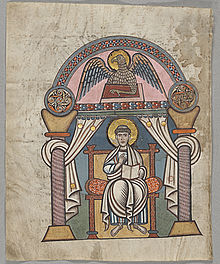Hanging bowl
Hanging bowls are a distinctive type of artefact of the period between the end of Roman rule in Britain in c. 410 AD and the emergence of the Christian Anglo-Saxon kingdoms during the 7th century, continuing rather later.
The ornament of these plates is often very sophisticated, and in many cases includes beautiful coloured enamel work, commonly in champlevé and using spiral motifs.
Their production is also evidenced in Pictish and Irish contexts, but they seem almost completely absent from the Brittonic areas of Wales, Devon and Cornwall.
The theory that they were used as maritime compasses, with a magnetic pin floated on water within the bowl, is discounted because many have an iron band around the rim which would render this unworkable.
Part of the puzzle lies in whether the bowls were normally suspended by threads from a central fulcrum (like a lamp), or from hooks on a tripod with tall wooden legs.
The spiral ornament developed through the 6th to 7th century invention of the 'trumpet-spiral' pattern, which was afterwards adopted from these enamels and incorporated into the repertoire of the famous painted Gospel-books such as the Book of Durrow or the Lindisfarne Gospels.




